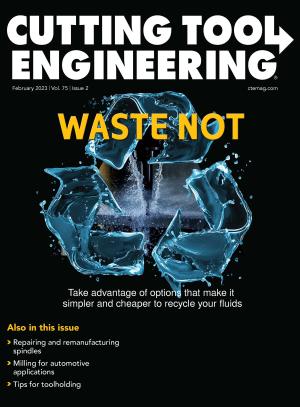After a few decades of machining in several industries, I have been afforded many opportunities to learn things the hard way. Numerous machine crashes, countless broken tools and lots of parts coming out of vises have taught me much about what not to do.
Some lessons were one- or two-minute events in which I walked away saying, “I won’t do that again.” Others took more than one iteration for the education to sink in and usually ended with me asking, “Why did I do that again?” In most instances, these were inexpensive mistakes that caused more frustration than damage. But in several cases, I really wrecked some stuff and the lessons were expensive or painful. Most teachings were learned through a series of events spread out over time, which we commonly just refer to as experience.
In time, experiences teach machinists to adopt their own general rules that are honed by successes and failures at the machine shop. Toolholding is a subject on which I have formulated opinions based on experiences that are worth sharing.
Total indicator runout of a toolholder needs to be only good enough. Buy a toolholder that does the job, but don’t overbuy. If you are drilling loose-tolerance clearance holes, a decent collet chuck often suffices. Likewise, if you need to ream holes with a 0.0005"-dia. tolerance, then a toolholder with very good TIR specs probably is warranted. Don’t let a cutting tool applications engineer scare you into expensive toolholders. Make suppliers provide tools aligned to your needs, not the marketing strategies of the suppliers.
Always use floating tapholders, even if a machine has rigid tapping capabilities. Modern machines have rigid tapping that synchronizes the spindle and tap axis, so special tapholders theoretically should not be necessary. However, it is easy to introduce small errors in programming and setups that can result in broken taps even when rigid tapping. A floating tapholder absorbs most minor errors, giving some insurance against broken taps, and a floating tapholder also improves the quality of a tapped hole.

Never use endmill holders with a setscrew. Go ahead and throw them out; they never have been any good. TIR is bad, grip on the tool is bad, the setscrews like to back out, and endmill holders are suitable for just one size shank. Setscrew-style endmill holders are good for only very large high-speed steel endmills, which have become all but extinct at modern shops. HSS endmills are obsolete technology.
Don’t fear collets. It is common for a cutting tool applications engineer or a salesperson to say he or she cannot guarantee performance if you don’t use a specific type of toolholder, such as hydraulic or shrink-fit styles. In these cases, please refer to my first general rule. A toolholder needs to be only good enough for the application. Collets like the ER style provide excellent TIR and gripping characteristics and can be used for milling, drilling and reaming in all but the most demanding situations. Collets are cheap, and — unlike shrink fit or hydraulic — most wrecks trash just the collet, not the toolholder.
Toolholders with spindle face contact are overrated and have a narrow application window. HSK and some of the CAT-style spindles that allow the toolholder flange to contact the spindle face are warranted when very heavy tools are used in the horizontal position or in high-spindle-speed applications. Most machining applications do not benefit from the additional cost of the spindle or toolholder. Significant testing is needed before investing in this technology.
HSK holders provide the best holder-to-spindle interface available on the market. If you are faced with high-volume applications or extremely close tolerances, HSK is the best choice. When spindle speeds reach the 12,000 rpm range, HSK is preferred. Not only does it have superior performance, but the spindles and toolholders have a superior cost. If a machining application requires hydraulic or shrink-fit holders for quality reasons, then an HSK interface is likely the best choice. Likewise, if machining can be done with ER collet chucks, then HSK is probably overkill.
Choose hydraulic toolholders before shrink fit. Hydraulic toolholders work by hydraulically deforming the inner diameter to grip the cutting tool, and they work very well. Shrink-fit holders are heated to expand, and when cooled they shrink to grip the tool. Shrink-fit holders grant the best TIR characteristics and have very narrow cross sections, allowing better clearance in tight areas. Hydraulic toolholders also have excellent TIR characteristics but are larger than shrink fit and have a limited reach. Hydraulic is the first choice because of safety and cost as shrink fit demands ancillary equipment to heat the holder and people are subject to burns when using shrink fit.
Buy a force gauge for the machine tool, and regularly check pull force. When a machine ages, the mechanisms that hold the tool in the spindle wear, causing pull force to degrade. The first indications of a problem are things like dropped tools, chatter and difficulty changing tools. By the time that a machinist recognizes these symptoms, the spindle may be damaged to the point that it must be removed from service. Each machine builder has a specification for pull force, and machines should be checked routinely as part of a preventive maintenance program. Spindle rebuilds are expensive and can result in significant downtime. The quality of a toolholder is irrelevant when the spindle taper is damaged.
Clean the spindle taper daily. Chips and debris from machining get between the toolholder and spindle. Cleaning tools that are made to fit the spindle taper are cheap and easy to use, and cleaning can be done in minutes. Like other preventive maintenance activities, cleaning the spindle averts costly failures.
Toolholding, like many subjects at a machine shop, can generate vigorous debates, and this list is probably no exception. These are simply the things that I have learned and that work for me.
Related Glossary Terms
- chatter
chatter
Condition of vibration involving the machine, workpiece and cutting tool. Once this condition arises, it is often self-sustaining until the problem is corrected. Chatter can be identified when lines or grooves appear at regular intervals in the workpiece. These lines or grooves are caused by the teeth of the cutter as they vibrate in and out of the workpiece and their spacing depends on the frequency of vibration.
- chuck
chuck
Workholding device that affixes to a mill, lathe or drill-press spindle. It holds a tool or workpiece by one end, allowing it to be rotated. May also be fitted to the machine table to hold a workpiece. Two or more adjustable jaws actually hold the tool or part. May be actuated manually, pneumatically, hydraulically or electrically. See collet.
- clearance
clearance
Space provided behind a tool’s land or relief to prevent rubbing and subsequent premature deterioration of the tool. See land; relief.
- collet
collet
Flexible-sided device that secures a tool or workpiece. Similar in function to a chuck, but can accommodate only a narrow size range. Typically provides greater gripping force and precision than a chuck. See chuck.
- endmill
endmill
Milling cutter held by its shank that cuts on its periphery and, if so configured, on its free end. Takes a variety of shapes (single- and double-end, roughing, ballnose and cup-end) and sizes (stub, medium, long and extra-long). Also comes with differing numbers of flutes.
- gang cutting ( milling)
gang cutting ( milling)
Machining with several cutters mounted on a single arbor, generally for simultaneous cutting.
- high-speed steels ( HSS)
high-speed steels ( HSS)
Available in two major types: tungsten high-speed steels (designated by letter T having tungsten as the principal alloying element) and molybdenum high-speed steels (designated by letter M having molybdenum as the principal alloying element). The type T high-speed steels containing cobalt have higher wear resistance and greater red (hot) hardness, withstanding cutting temperature up to 1,100º F (590º C). The type T steels are used to fabricate metalcutting tools (milling cutters, drills, reamers and taps), woodworking tools, various types of punches and dies, ball and roller bearings. The type M steels are used for cutting tools and various types of dies.
- inner diameter ( ID)
inner diameter ( ID)
Dimension that defines the inside diameter of a cavity or hole. See OD, outer diameter.
- milling
milling
Machining operation in which metal or other material is removed by applying power to a rotating cutter. In vertical milling, the cutting tool is mounted vertically on the spindle. In horizontal milling, the cutting tool is mounted horizontally, either directly on the spindle or on an arbor. Horizontal milling is further broken down into conventional milling, where the cutter rotates opposite the direction of feed, or “up” into the workpiece; and climb milling, where the cutter rotates in the direction of feed, or “down” into the workpiece. Milling operations include plane or surface milling, endmilling, facemilling, angle milling, form milling and profiling.
- shank
shank
Main body of a tool; the portion of a drill or similar end-held tool that fits into a collet, chuck or similar mounting device.
- tap
tap
Cylindrical tool that cuts internal threads and has flutes to remove chips and carry tapping fluid to the point of cut. Normally used on a drill press or tapping machine but also may be operated manually. See tapping.
- tapping
tapping
Machining operation in which a tap, with teeth on its periphery, cuts internal threads in a predrilled hole having a smaller diameter than the tap diameter. Threads are formed by a combined rotary and axial-relative motion between tap and workpiece. See tap.
- tolerance
tolerance
Minimum and maximum amount a workpiece dimension is allowed to vary from a set standard and still be acceptable.
- toolholder
toolholder
Secures a cutting tool during a machining operation. Basic types include block, cartridge, chuck, collet, fixed, modular, quick-change and rotating.
- total indicator runout ( TIR)
total indicator runout ( TIR)
Combined variations of all dimensions of a workpiece, measured with an indicator, determined by rotating the part 360°.
- total indicator runout ( TIR)2
total indicator runout ( TIR)
Combined variations of all dimensions of a workpiece, measured with an indicator, determined by rotating the part 360°.


